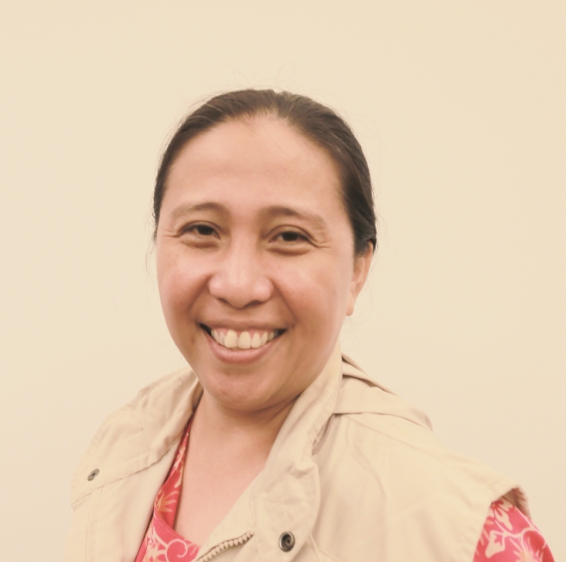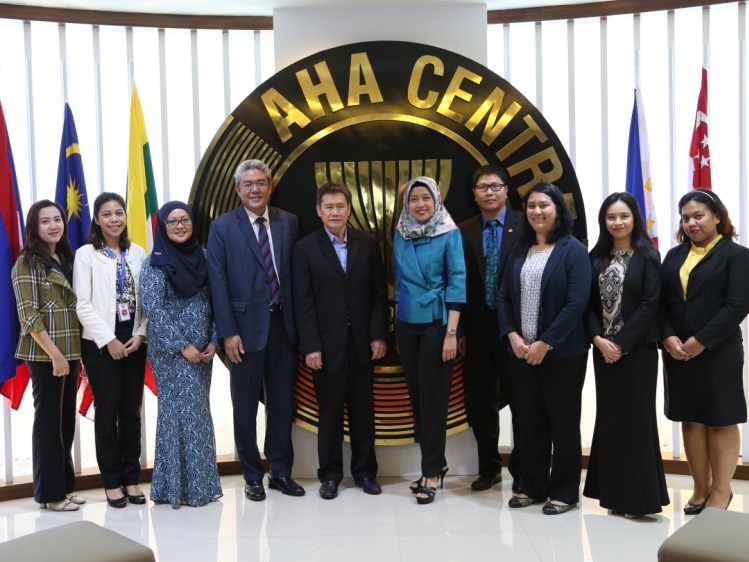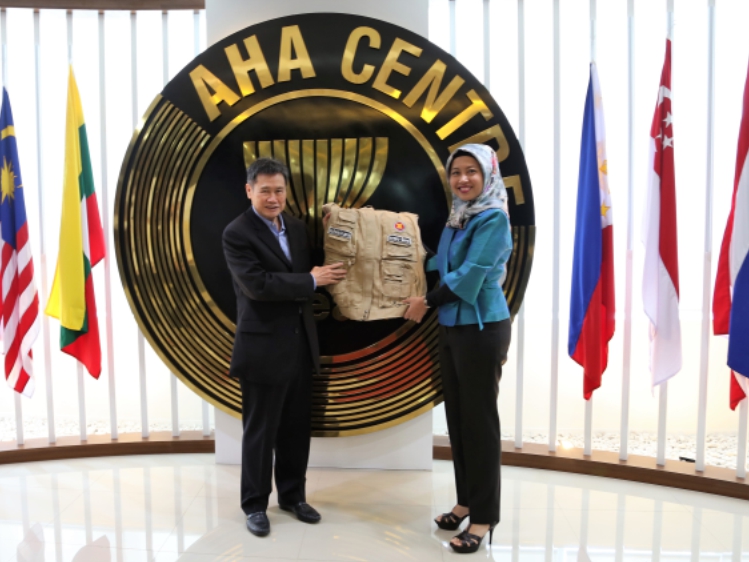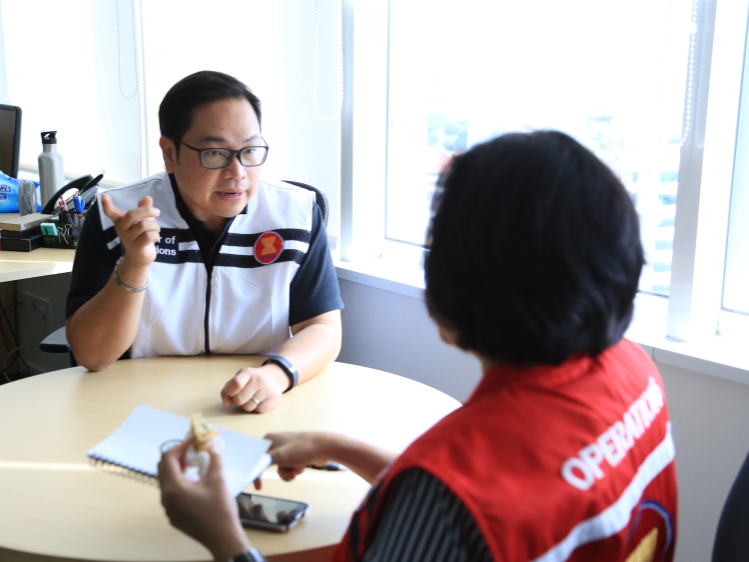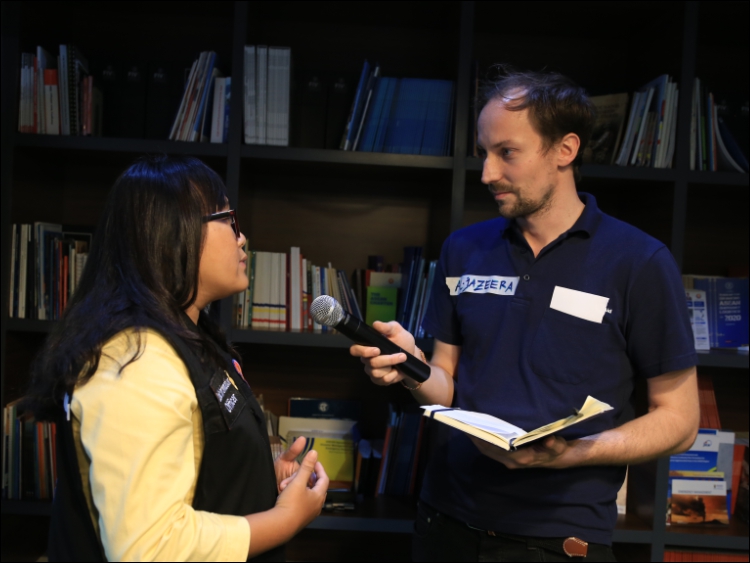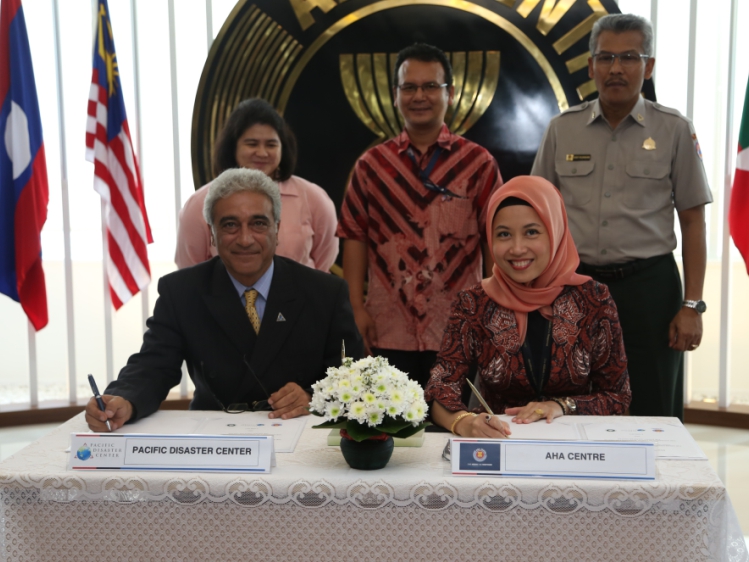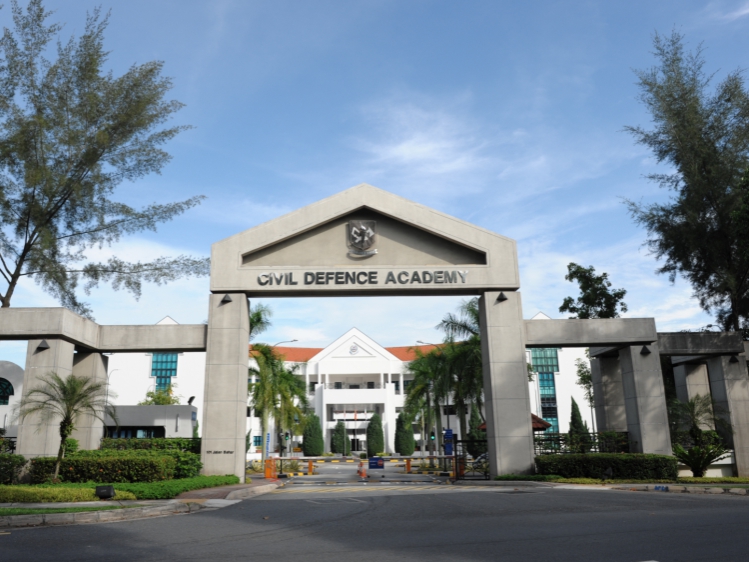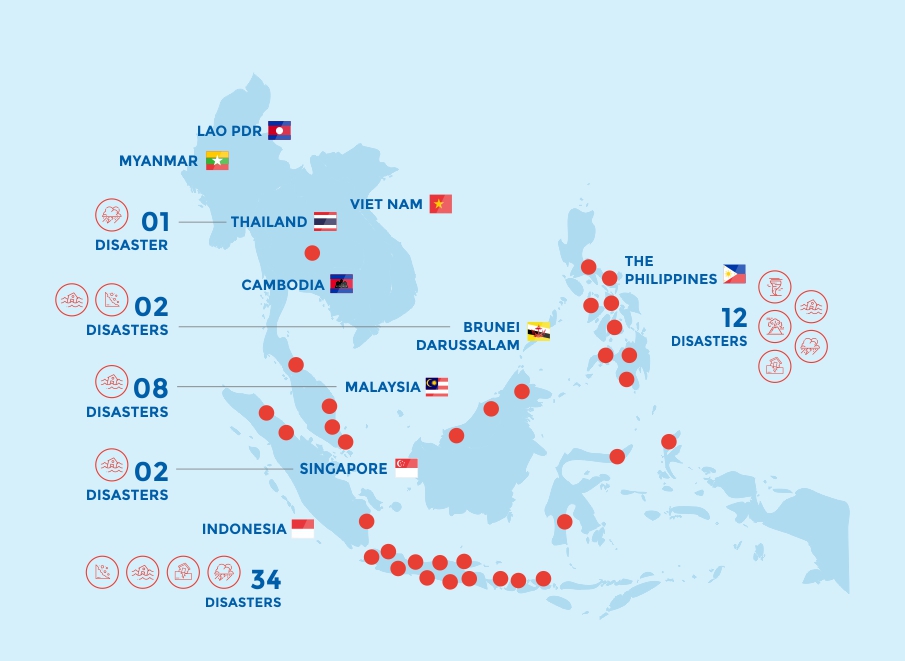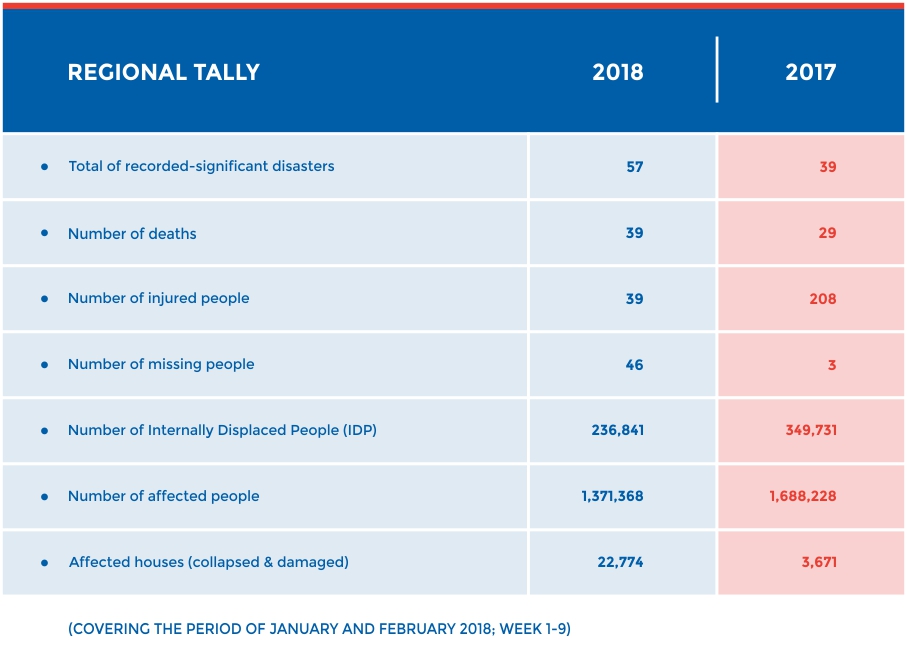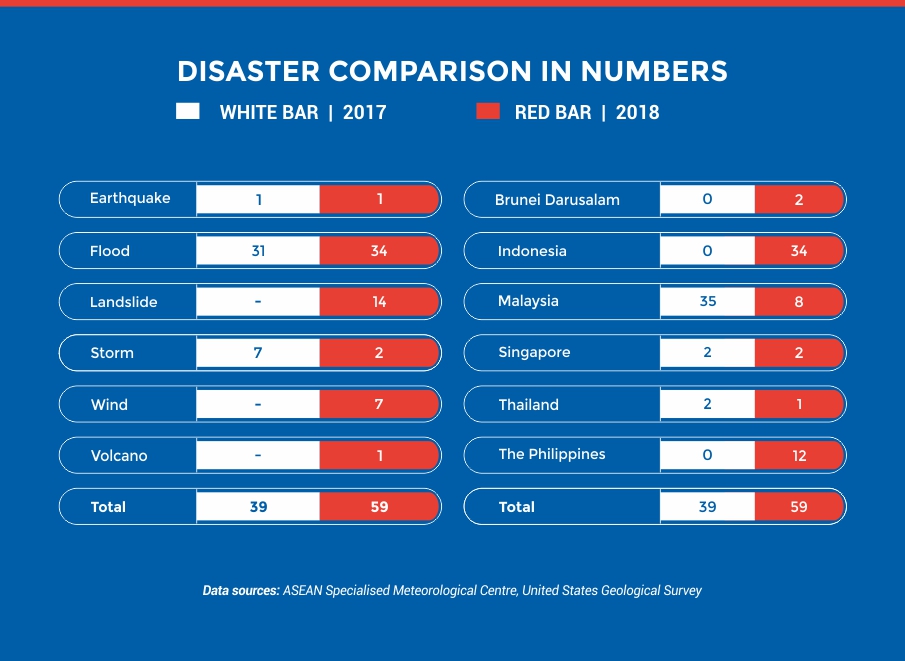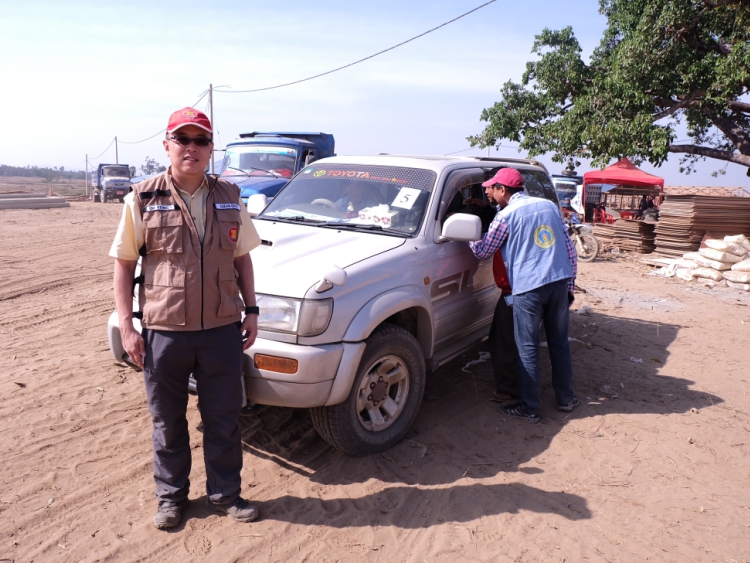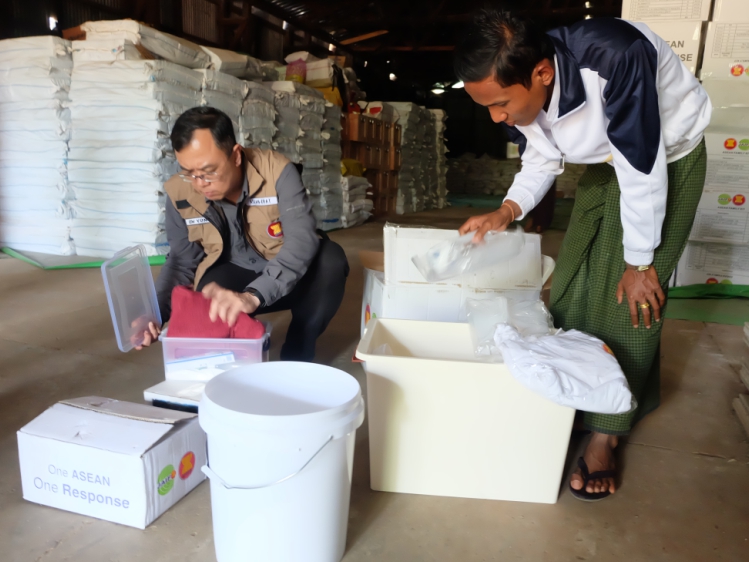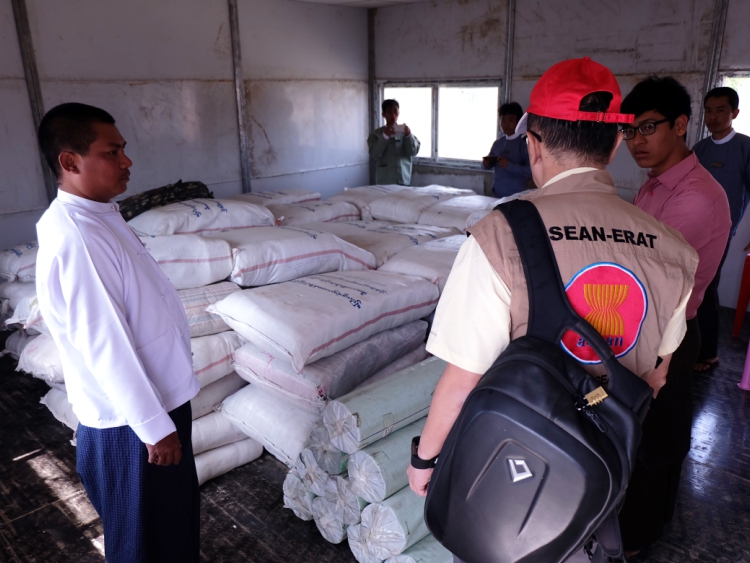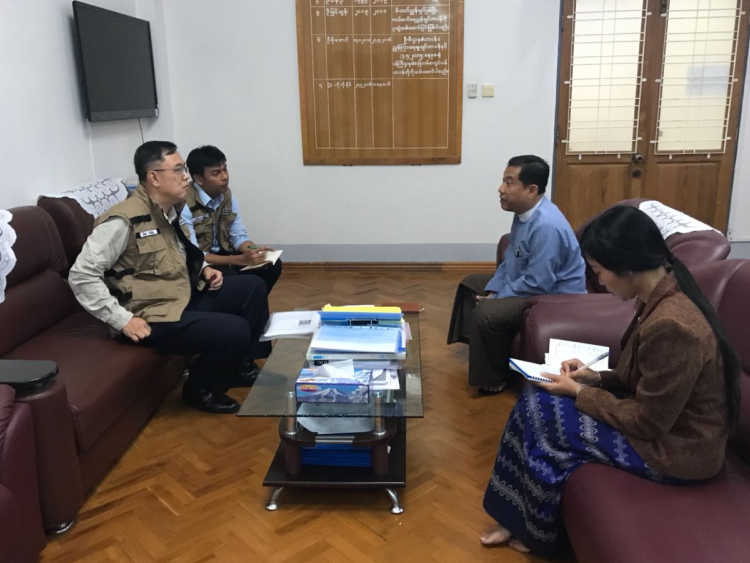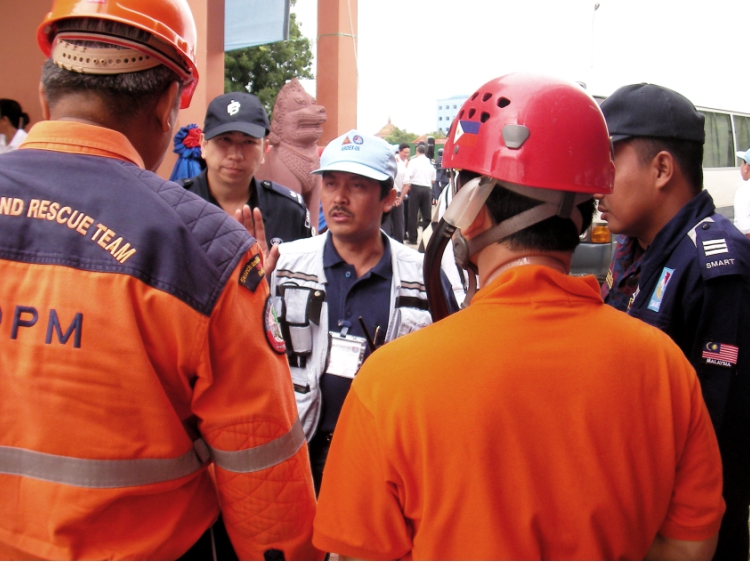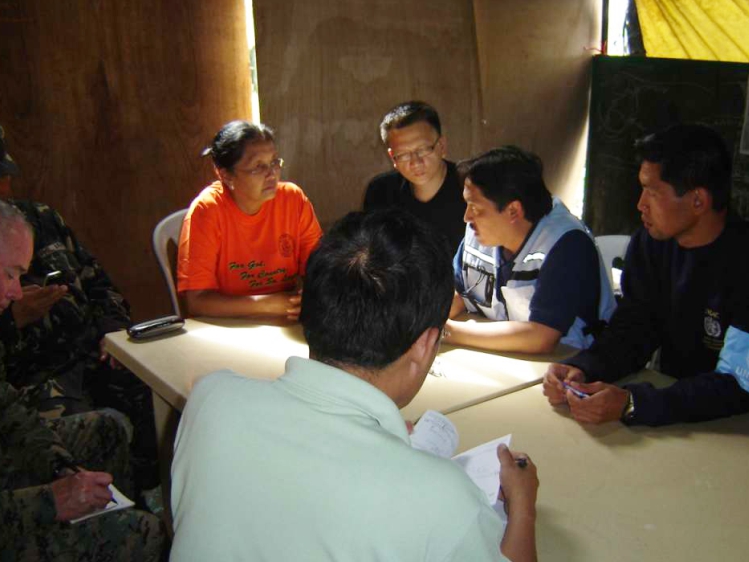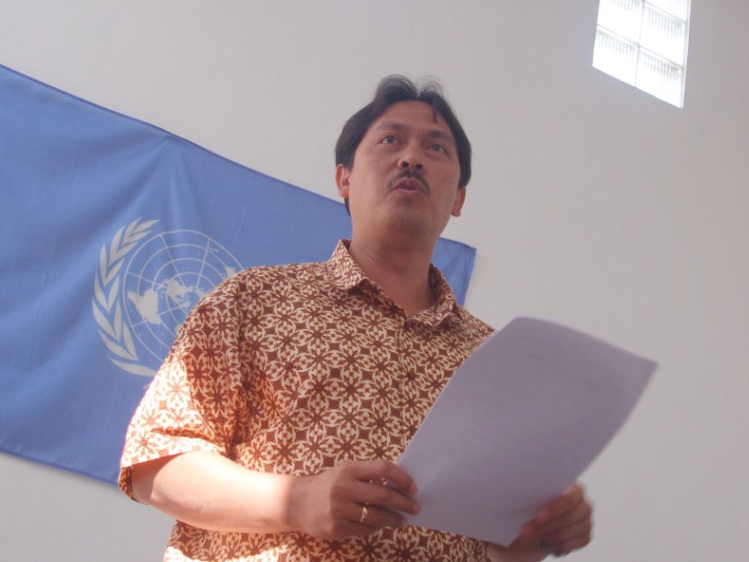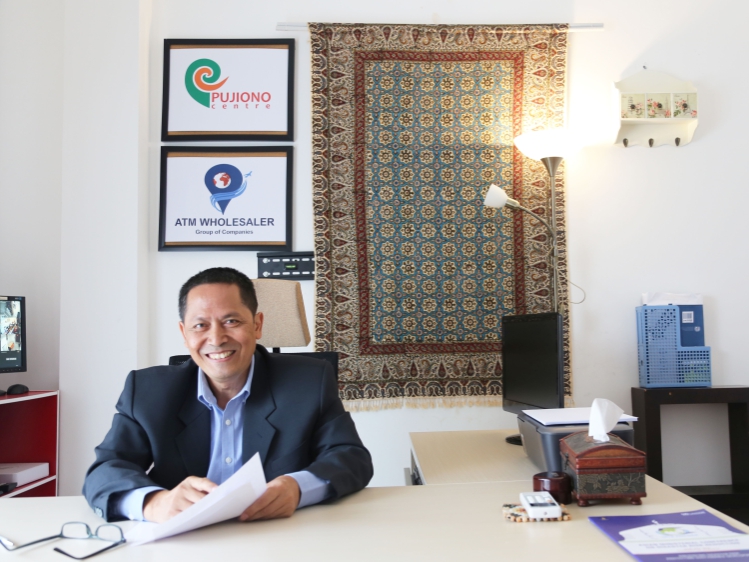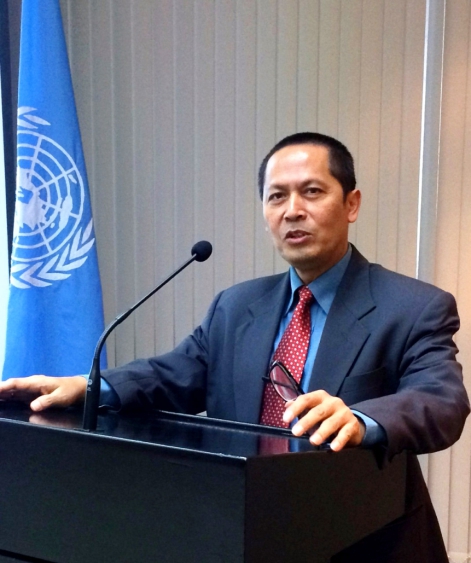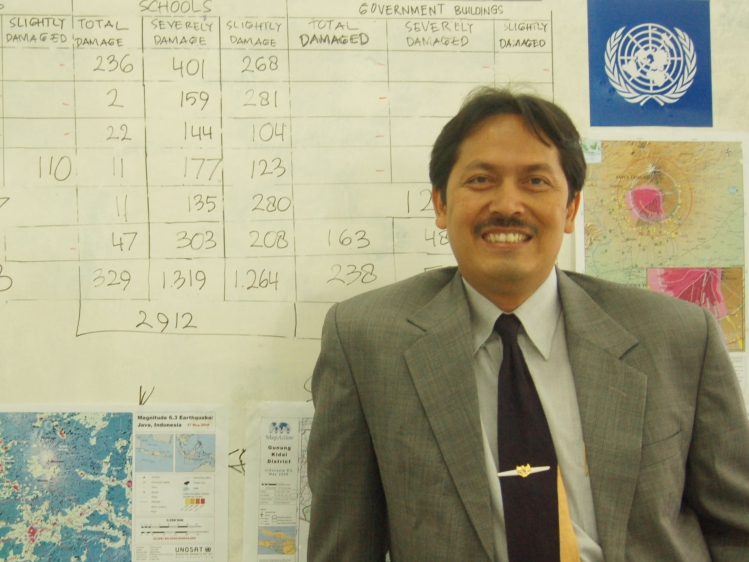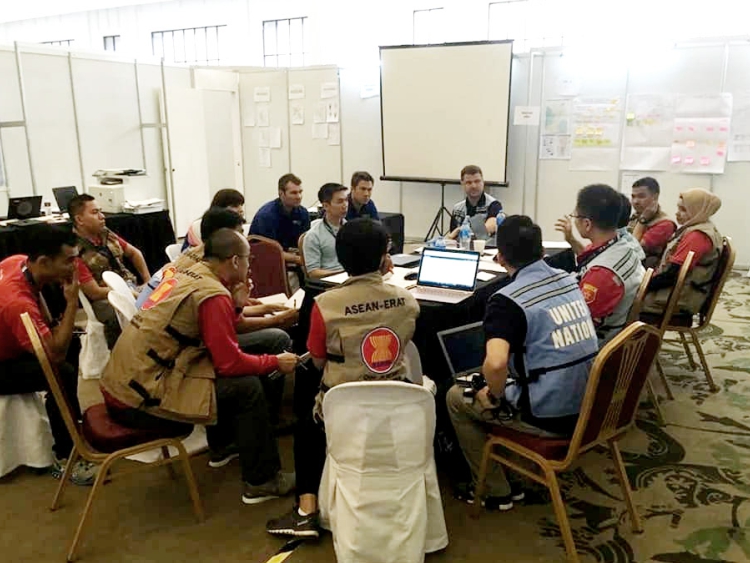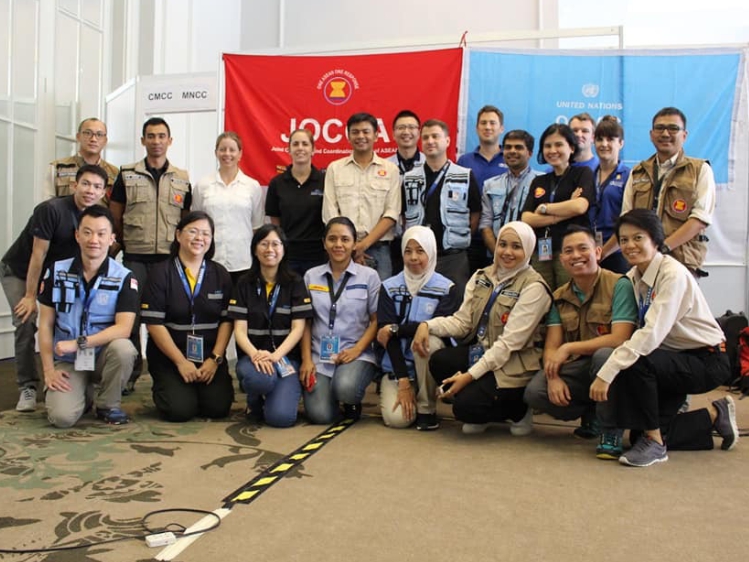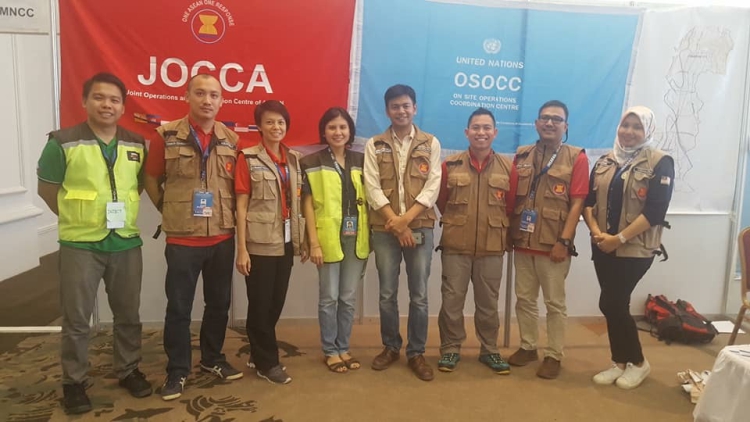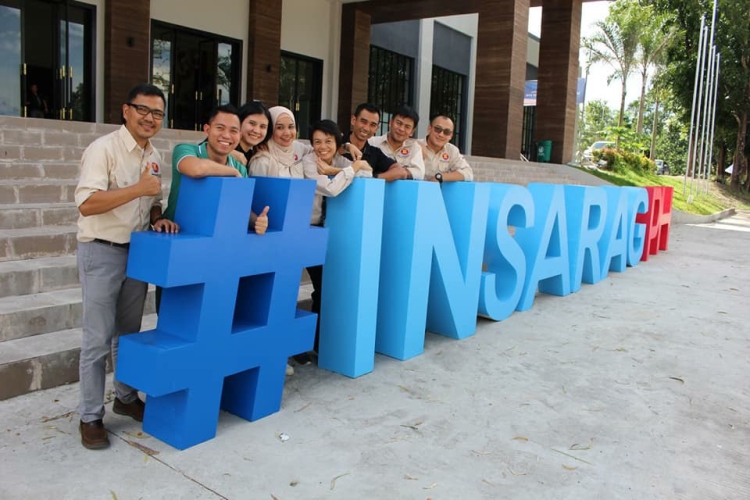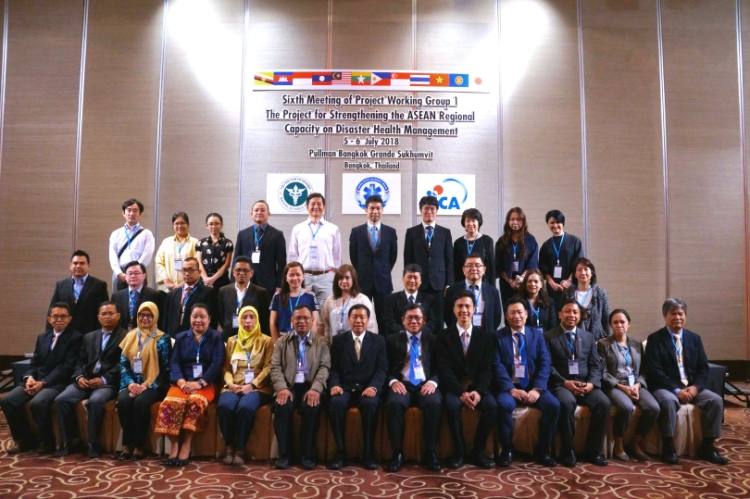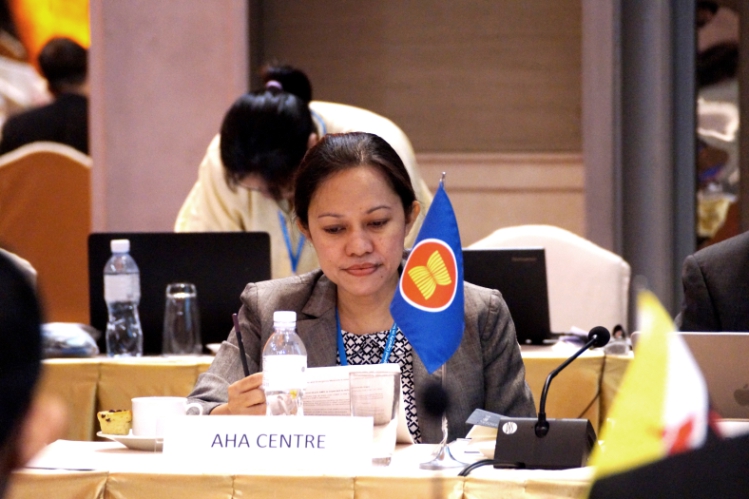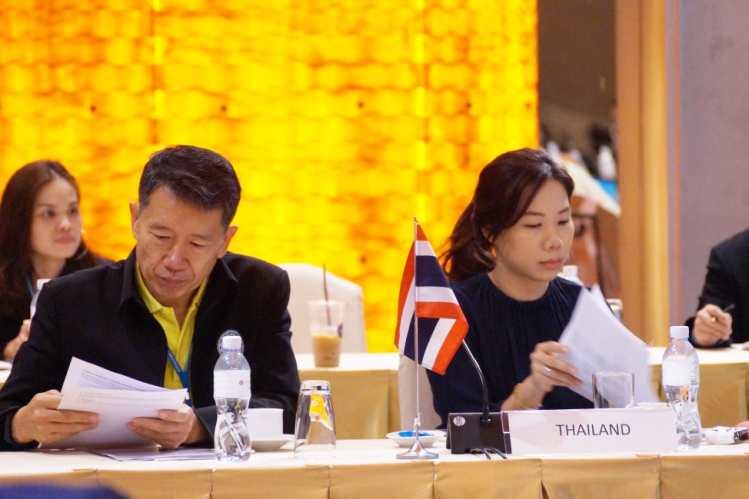Vol 36-Gaynor Tanyang

Gaynor Tanyang
Managing Director, Lumina Ventures
ASEAN-ERAT Member from the Philippines
Gaynor’s path into the disaster management field, and direct engagement as an ASEAN ERAT member was formed through more than ten years of work in the development sector. Her first experience directly with disaster management in the ASEAN context came when she joined Oxfam on a programme being implemented within the AADMER partnership. She tells the AHA Centre, “I was just volunteering with a local organisation, when a contact recommended I apply for the role”.
Having gained some disaster-related experience in her time undertaking gender audits of disaster responses, Gaynor first heard of the AHA Centre through Oxfam’s support to the ASEAN Secretariat developing this new disaster management institution in 2011. She then acted as an observer of the 2013 ASEAN-ERAT training course, managing the simulation exercises, before strengthening her involvement by undertaking the role of facilitator during a 2014 ASEAN-ERAT refresher training. It is this training element that forms a large part of Gaynor’s passion for the work. “Most of my work with NGOs involved training, so that is what I really enjoy most” she states.
As an ASEAN-ERAT member, Gaynor has experienced one deployment. It was this deployment, however, that influenced significant change in the landscape and format of the ASEAN-ERAT course. The deployment was to her home nation of the Philippines, and the assignment was as an initial responder to the devastating Typhoon Haiyan that struck Tacloban in late 2013. Gaynor’s arrival into the affected area was an experience that would stay with her. “Usually, even after a disaster, there are still markets, and people are still going about their lives – but Haiyan was different.
Everything was destroyed. There were no markets, no shops open – no-one cared about your money” she recalls. “When we arrived in Tacloban, our only water was a half-bottle left over from our lunch”.
“AT THAT TIME, WE WERE NOT FULLY PREPARED, AND THIS PREPAREDNESS IS A KEY LESSON WE LEARNED FROM HAIYAN.” GAYNOR ADMITS. “TRAINING CAN HELP YOU PREPARE TO SOME DEGREE, BUT HAIYAN WAS JUST SO DIFFERENT. THE DEVASTATION WAS SO MASSIVE. ALL ASPECTS OF LOGISTICS WERE EXTREMELY CHALLENGING.”
Local knowledge and connections formed key elements of Gaynor’s and the other ASEAN-ERAT members’ ability to gain access to the disaster zone. Without their local Filipino contacts, gaining vehicles and transportation would have been almost impossible. This stands as one of Gaynor’s tips to first responders – “take advantage of local connections and personal contacts”.
The lessons learned from the Haiyan response have guided the AHA Centre during its more recent development, and Gaynor played a central role in the development of these lessons and the recommendations that followed. “After my experience in Haiyan, I realised that the ERAT course needed some changes” she recalls. Her input was accomodated when the AHA Centre expands the roles of ASEAN-ERAT, from assessment towards responses, including pre-deployment preparation. Regarding this preparedness, Gaynor’s primary tip to responders is to “expect the worse – take a bare minimum of items to survive in trying conditions and always carry a strong sense of purpose.”
Written by : William Shea | Photo : AHA Centre
- Published in The Other Side
Vol 36-AHA Centre Welcomes The New ASEAN Secretary-General

AHA CENTRE WELCOMES
THE NEW ASEAN SECRETARY-GENERAL
2 FEBRUARY 2018
Within a month of his appointment as the new Secretary-General of ASEAN, H.E. Dato Paduka Lim Jock Hoi visited the home of One ASEAN, One Response – the AHA Centre. Together with Deputy Secretary-General of ASEAN Socio-Cultural Community, H.E. Vongthep Arthakaivalvatee, and other ASEAN Secretariat delegates, Dato Lim Jock Hoi undertook a tour of the AHA Centre’s office in East Jakarta. During this visit, the Executive Director and staff of the AHA Centre shared updates regarding the activities of the organisation, as well as the updated status of the standby relief items in ASEAN’s warehouse.
The Secretary-General was highly supportive of the AHA Centre, and stated his aspiration to enhance multilateral and cross-sectoral cooperation for disaster management in the region. H.E. Lim Jock Hoi further commended the work of the AHA Centre and recommended that the AHA Centre continue to share information about its work and activities, coordinating disaster management across ASEAN. Alongside this, he also committed to support the AHA Centre in its resource mobilisation efforts.
Before his departure, the AHA Centre presented Dato Paduka Lim Jock hoi with an ASEAN vest embroidered with his Excellency’s name. The AHA Centre fully supports the leadership of Dato Lim Jock Hoi as the 14th Secretary-General of ASEAN as well as the ASEAN Humanitarian Assistance Coordinator, and looks forward to further collaboration during his tenure throughout the next five years.
Written by : Shintya Kurniawan | Photo : AHA Centre
- Published in AHA Centre Diary 2
Vol 36-Practice Makes Perfect

PRACTICE MAKES PERFECT
SIMULATION EXERCISE WITH GIDRM AND SDC, 24-25 JANUARY 2018
AT 04:23AM, THE AHA CENTRE’S WHATSAPP GROUP WAS ALIGHT WITH MESSAGES, AS STAFF IN JAKARTA AND BEYOND WERE ROUSED FROM THEIR SLEEP BY THE NEWS OF AN EARTHQUAKE. THIS SIMULATED EARTHQUAKE EVENT FORMED THE BEGINNING OF THE AHA CENTRE’S EXERCISE WITH GIDRM AND SDC.
EXERCISE
A 7.9 Magnitude earthquake was recorded near Pontianak with 10 Km depth. Disaster Monitoring and Analysis will update if there is a tsunami advisory issued.
EXERCISE
Twelve minutes later, another message appears on the mobile phone screens of the group.
EXERCISE
Given the shallow depth, tsunami warning may be triggered for Indonesia, Malaysia, and Singapore.
These alerts were followed by a request to gather at the AHA Centre’s Emergency Operations Centre at 7 a.m. and series of internal coordination meetings for the next 36 hours. For the first time ever, the AHA Centre was involved in a two-day scenario, responding to a fictitious large-scale disaster which presumably affected three ASEAN Member-States. Every few hours, new injects were given and complicate the situation. The injects include, among others, a biohazards leakage at an industrial area in Pontianak and a kidnapping case of the ASEAN-ERAT member.
This unique scenario helped staff to practice their internal preparedness and response mechanisms. At the end of the exercise, the AHA Centre evaluated its response mechanism, noting gaps and weaknesses, and discussed the solutions that could support the improvement of the organisation’s readiness in responding to complex disaster situations. This interesting and engaging exercise was facilitated by the Global Initiative on Disaster Risk Management (GIDRM) and the Swiss Agency for Development and Cooperation (SDC).
Written by : Shintya Kurniawan | Photo : AHA Centre
- Published in AHA Centre Diary 1
Vol 36-Pacific Disaster Centre

PACIFIC DISASTER CENTRE
Strengthening Disaster Preparedness across Asia-Pacific
with the Pacific Disaster Centre
THE PACIFIC DISASTER CENTER (PDC) IS A HAWAIIAN-BASED ORGANISATION WITH A FOCUS TOWARDS DEVELOPING TECHNOLOGICAL INNOVATIONS FOR IMPROVING DISASTER MITIGATION, PREPAREDNESS, RESPONSE, AND RECOVERY. FOR ALMOST TWO DECADES, PDC HAS DELIVERED A VARIETY OF TOOLS AND SERVICES TO THE GLOBAL DISASTER MANAGEMENT COMMUNITY – INCLUDING TO THE AHA CENTRE. SUCH TOOLS AND SERVICES INCLUDE GLOBAL MULTI-HAZARD DISASTER MONITORING, EARLY WARNING MECHANISMS AND DECISION SUPPORT SYSTEMS, RISK AND VULNERABILITY ASSESSMENT TOOLS, MODELING AND VISUALISATION PLATFORMS, SIMULATION EXERCISE SUPPORT, AND A RANGE OF CAPACITY DEVELOPMENT ACTIVITIES.
ASEAN’s collaboration with the PDC began in mid-2004, prior to the Indian Ocean Tsunami, and the PDC has been constantly involved in the implementation of the ASEAN Agreement on Disaster Management and Emergency Response (AADMER). More recently, the PDC – supported by the United States Government through its US Agency for International Development (USAID) programmes – has worked with ASEAN and the AHA Centre to implement programmes such as the AADMER Work Programme for Risk Assessment, Early Warning, and Monitoring Activity (2010-2015), the AHA Centre Information Communication Technology (ICT) Gap Analysis, and the development of a Disaster Monitoring and Response System (DMRS) powered by PDC’s DisasterAWARE™ platform.
The most notable recent collaboration between the two Centres has been the development of the DMRS. The system was initiated following an offer made by the United States’ President Barack Obama at the First ASEAN-US Leaders’ Meeting in November, 2009, in Singapore. The DRMS is supported by the United States Government through the USAID and US Department of State-funded ASEAN-US Technical Assistance and Training Facility. The United States has been an ASEAN Dialogue Partner since 1977.
The DMRS enables the AHA Centre to integrate all monitoring of hazard data within one system. The system compiles and transforms various hazard and other natural disaster information from national and international disaster monitoring agencies into a regional, event-tracking and decision-support tool, further enhanced by its utilisation of maps and modelling applications. Through this integration, the AHA Centre operations team can immediately obtain a global overview of any situation, which improves response times and leads to more efficient use of relief resources.
“I would characterise PDC as a very committed and sustainable partner of the AHA Centre. Through their support, we now have comprehensive disaster monitoring tools that allow us to monitor hazards in an almost real-time manner. The early warning alerts allow us to plan ahead of time,” explains Arnel Capili, the Operations Director of the AHA Centre.
Following more than a decade of collaboration, The PDC and the AHA Centre signed a new Memorandum of Intent (MOI) on the 5th of June, 2017, at the AHA Centre’s headquarters in Jakarta.
The MOI aims to strengthen the two Centres’ ongoing partnership in advancing disaster risk reduction and regional cooperation, including steps to progress the vision of One ASEAN One Response. The PDC and AHA Centre will continue working together to pursue new endeavours to support the vision, including a project to conduct a regional risk assessment for the ASEAN Member States that will support the development of sound policies for risk reduction across the region.
Written by : Carla Budiarto | Photo : AHA Centre
- Published in Partnership
Vol 36-Singapore’s Disaster Overview

SINGAPORE’S
DISASTER OVERVIEW
Due to its geographical location which is outside the ‘Pacific Rim of Fire’, Singapore is spared from natural disasters such as tsunamis, earthquakes, and volcanic eruptions. However, Singapore cannot insulate itself from disaster prevention and management efforts as it is still susceptible to man-made disasters; which can be in the form of terror attacks or hazmat incidents. The Singapore Civil Defence Force (SCDF), under the command of Ministry of Home Affairs, is the National Authority that will coordinate, plan, command and control all operations undertaken by the various agencies to mitigate major disasters.
SINGAPORE’S CONTRIBUTION TO REGIONAL AND GLOBAL DISASTER MANAGEMENT EFFORTS
Due to the increased interconnectivity between the ASEAN Member States, the effects of a natural disaster on a particular Member State can also affect the entire ASEAN region. In this regard, Singapore is strongly
engaged not only in ASEAN but also on a global scale, and strive to be a leader in disaster preparedness and response practices.
Singapore is represented in the United Nations Disaster Assessment and Coordination (UNDAC) Advisory Board and the International Search and Rescue Advisory Group (INSARAG) Steering Group, helping to shape strategies and policies for adoption globally by the disaster management fraternity. The 76-member SCDF Ops Lionheart team is the first team in the Asia-Pacific region to be classified as a “Heavy” Urban Search and Rescue (USAR) team under the INSARAG External Classification (IEC) – the highest classification provided to USAR Teams by the United Nations. SCDF’s Ops Lionheart Contingent had been deployed to 17 overseas humanitarian assistance and disaster relief missions and is constantly on standby to offer assistance to any country which has been struck by disasters such as earthquakes, floods or tsunamis.
Other than the SCDF’s Ops Lionheart Contingent, SCDF has a pool of trained officers on standby round the clock throughout the year, ready to be activated alongside international humanitarian partners in disaster coordination in the following capacities:
⋅ Active UNDAC members who have supported several overseas missions and exercises regularly;
⋅ One of the founding members of Asia-Pacific Humanitarian Partnership (APHP). SCDF has an Information and Communication Technology (ICT) Support Module Team that can support the UNDAC operations at the disaster site with specified communications equipment and assist in establishing the On Site Operations Coordination Centre (OSOCC);
⋅ Specialised officers trained to form the Hazmat Assessment Unit (HAU) that respond to environmental emergencies in support of the UN Joint Environment Unit (UN-JEU); and
⋅ Operational officers trained as ASEAN Emergency Response and Assessment Team (ASEAN-ERAT) that supports the humanitarian assistance and disaster relief missions that are coordinated by the AHA Centre.
Some of the recent major disasters which SCDF has provided support included the deployment of ASEAN-ERAT for the Aceh Earthquake in 2016, Ops Lionheart mission for the Nepal earthquake in 2015, responding to the Malaysian floods in 2014, the Christchurch earthquake in 2011, APHP support for Typhoon Haiyan in 2013 and UNDAC/APHP support for Typhoon Bopha in 2012.
Singapore has also played a key role in the ASEAN regional disaster management efforts. At the regional front, the SCDF serves as Singapore’s focal point for the ASEAN Committee on Disaster Management (ACDM), and a member of the Governing Board of the AHA Centre. Together with Indonesia, Philippines and the ASEAN Secretariat, Singapore was a member of the Task Force set up in 2009 for the establishment of the AHA Centre and played a pivotal role in the operationalisation of the Centre, particularly in the setup of its ICT infrastructure and systems. As co-chairs of two of the ACDM Working Groups; Preparedness and Response with Malaysia and Knowledge and Innovation Management with Indonesia and Viet Nam, Singapore through the SCDF drives several key initiatives under the AADMER Work Programme. This includes the development of ASEAN Standby Arrangements and Standard Operating Procedures, or SASOP, ASEAN Joint Disaster Response Plan, establishment of ASEAN-ERAT, Disaster Emergency Logistics Systems for ASEAN, and developing thought leadership in ASEAN through the hosting of the annual Strategic Policy Dialogue in Disaster Management and the Senior Executive Programme in Disaster Management.
Singapore is actively engaged in a range of disaster management activities and shares her best-in-class practices, systems and processes with the international community through overseas exchange programmes, rescue assistance, and the provision of a plethora of training courses in disaster management. Singapore’s Civil Defence Academy, established in March 1999, conducts a wide range of training for the international community. The Academy frequently leverages on technology and has incorporated the use of immersive virtual technology for decision making and command training. CDA’s flagship programmes include the International Firefighting, Hazardous Materials (HazMat) and USAR courses. Besides training the operational personnel and developing countries, CDA has also been training senior officials at the strategic-level and developed countries through the conduct of courses such as the Leadership Programme in Disaster Management and Disaster Risk Reduction and Response Course.
Written by : William Shea | Photo: SCDF
- Published in Insight
Vol 36-Monthly Disaster Outlook

MONTHLY DISASTER REVIEW OUTLOOK
JANUARY AND FEBRUARY 2018 | DISASTER MONITORING & ANALYSIS
(DMA) UNIT, AHA CENTRE
GENERAL OVERVIEW OF JAN AND FEB 2018
Between January and February 2018, a total of 57 disasters were reported from within ASEAN Member States. Due to the higher-than-average rainfall; 57.8% of all disasters reported in this period are attributed to floods. In addition, landslides are of major concern in areas prone to slope failure which potentially cause disruptions and significant damage to major circulatory transport systems, as well as impacting communities and trade. In the northern ASEAN region, record-low temperatures have been reported during this winter season, with storms recorded in Viet Nam, Thailand and Cambodia. Whereas the emergency response operation for Typhoon Tembin was extended until the third week of January, additional impact of Tropical Storm Sanba (Basyang) affected more than two hundred-thousand people in the Philippines.
Earthquakes and volcanic activity remain high on the agenda, with two significant earthquakes observed in the region. A magnitude 6.1 earthquake occurred on the 23rd of January 2018, affecting provinces of Banten, West Java and Jakarta in Indonesia. Although there were over seven thousand homes damaged, the emergency response was managed well by the Indonesian authorities. More recently, a magnitude 7.6 earthquake was recorded in Papua New Guinea on February 26th, with tremors felt and light damage caused in several regencies of the Papua Province (Indonesia). The earthquake was followed by 53 strong aftershocks (M 5.0 and above) within the following week, without additional damage experienced in any parts of Indonesia. Also in Indonesia, the situation on Mount Agung, Bali, has greatly improved, with its alert level being lowered, and its mandatory exclusion zone relaxed. In the Philippines, Mount Mayon’s Phreatomagmatic Eruption, has been ongoing throughout January & February. This activity has affected the daily lives of more than 90,000 people in the Albay Province, yet there have been no human casualties reported, showcasing the result of effective preparedness and response.
OUTLOOK FOR MARCH AND APRIL 2018
ASEAN Specialised Meteorological Centre (ASMC) has forecasted that during the coming months, the region will begin a gradual transition from the current Northeast Monsoon season to the inter-monsoon period. The inter-monsoon period (April and May) is a transition period that sees low-level winds in the region being generally light and variable in direction, with an increase in light rain activity expected across ASEAN during this time.
For the March-April-May 2018 season, slightly below-average to near-average rainfall is forecasted for most parts of Southeast Asia, except for the Philippines, who can expect slightly above-average rainfall during these months. During March and April, slightly above-normal rainfall is forecasted over the northern parts of Kalimantan and Sulawesi, as well as the western districts of Papua.
Written by : Mizan Bisri, Qing Yuan Pang
DISCLAIMER
AHA Centre’s estimation is based on data and information shared by National Disaster Management Organisations (NDMOs) and other relevant agencies from ASEAN Member States, international organisations and news agencies. Further information on each recorded-significant disaster, description and details of data and information are available at: http://adinet.ahacentre.org/reports.
- Published in Monthly Disaster Outlook
Vol 36-ASEAN-ERAT Mission in Rakhine, Myanmar

ASEAN-ERAT
MISSION IN RAKHINE, MYANMAR
As part of its ongoing efforts to assist displaced population in Myanmar’s Rakhine State, the AHA Centre deployed ASEAN Emergency Response and Assessment Team (ASEAN-ERAT) personnel to Myanmar from the 15th – 31st of January, 2018. Tasked to support the work of the Disaster Management Department of Myanmar, the deployed ERAT team was made up of members from the Philippines and Singapore, alongside one AHA Centre staff.
THIS DEPLOYMENT OF ASEAN-ERAT PERSONNEL HAD THREE PRIMARY OBJECTIVES:
1. Observing the status of ASEAN’s relief items that were previously provided through the AHA Centre;
2. Supporting the Emergency Operations Centre (EOC) of Myanmar’s Disaster Management Department with information management, secondary data analysis, and report writing;
3. Undertaking preparations for the next ASEAN-ERAT Induction Course that will be held in Myanmar later in 2018.
Between October 2017 and January 2018, the AHA Centre facilitated the provision of 80 tonnes of relief items, delivered in two batches from the ASEAN regional stockpile in Subang, Malaysia. In December 2017, additional relief items were locally procured by utilising a S$100,000 contribution from the Government of Singapore. Part of this deployment mission included a two-day field observation to Rakhine State, through which the ASEAN-ERAT members confirmed that the distribution of relief items was undertaken as reported by the Disaster Management Department of Myanmar.
The ASEAN-ERAT team also observed the state of temporary shelters, prepared by the Government of Myanmar for displaced communities in Rakhine, as well as those that may return from outside the State. This temporary settlement is equipped with clean water, as well as pre-positioned materials such as clothes, food, and kitchen sets.
In addition to the existing efforts, the Government of Myanmar has developed a stockpile of contingency relief items in Sittwe and Maungdaw, in anticipation of future events, such as flooding, during the approaching monsoon season. Throughout their mission, the ASEAN-ERAT members worked closely with the Director-General and staff of the Disaster Management Department, alongside the Myanmar Red Cross, the General Administration Department in Rakhine, and the Fire Services Departments in Nay Pyi Taw, Yangon, and Rakhine. They worked together conducting a needs assessment, and developing recommendations to further enhance the ongoing provision of humanitarian assistance to the affected communities in Rakhine State.
“THE AHA CENTRE WOULD LIKE TO THANK THE GOVERNMENT OF MYANMAR FOR WELCOMING OUR ASEAN-ERAT MEMBERS TO WORK IN NAY PYI TAW AND RAKHINE STATE. THE MISSION DEMONSTRATES ASEAN’S SOLIDARITY, HELPING ONE ANOTHER IN TIMES OF DIFFICULTY, UNDER THE SPIRIT OF ONE ASEAN ONE RESPONSE,” SAID ADELINA KAMAL, EXECUTIVE DIRECTOR OF THE AHA CENTRE.
Written by : Shintya Kurniawan | Photo : AHA Centre
- Published in Highlight
Vol 40-Dr.Puji Pujiono

DR.PUJI PUJIONO
Dr. Puji Pujiono, the Founder and Senior Adviser of the Pujiono Centre and now a businessman, is one of the ASEAN region’s most respected and renowned disaster management experts. His reputation in the humanitarian and disaster management fields is acclaimed across regions from his works with numerous United Nations agencies, the ASEAN Secretariat, and organisations such as the Indonesian Red Cross to name just a few. A social worker by training and profession, Dr. Pujiono was naturally drawn into the disaster risk management sector through his firm belief and passion in humankind’s resilience to overcome adversities and great challenges.
It was Dr. Pujiono’s work with the UN Refugee Agency in the early 2000’s that introduced him to the ASEAN structure. “It was at the conclusion of the first emergency preparedness training in Indonesia that I saw potential to sow the seed for regional cooperation in disaster management” he says. In one of the then-obscure provisions in the 1976 ASEAN Declaration on Mutual Assistance on Natural Disasters, he found content regarding Member States’ commitment to assist other Member States that are in distress. Dr. Pujiono tells us that during a session of the ASEAN Experts Group Meeting on Disaster Management, he put forward three hard-to-resist proposals. “The resources to meet every six months instead of every two years, my own expertise to support the group, and my own professional networking to connect ASEAN with the rest of the world of disaster management….and they jumped at it”, he recalls.
Within the 18 months following that meeting, the infrastructure for ASEAN regional cooperation was instituted, that included the first ASEAN Ministerial Meeting on Disaster Management, a full-fledged ASEAN Committee on Disaster Management (ACDM), ASEAN Regional Programme on Disaster Management (ARPDM), and a draft regional agreement. The pivotal Indian Ocean Tsunami in December 2004 and the World Conference on Disaster Risk Reduction in Hyogo, Japan, in early 2005 presented the unprecedented momentum to accelerate the draft into what is now known as the ASEAN Agreement on Disaster Management and Emergency Response (AADMER). The Agreement sparked the idea to establish the AHA Centre, and since then has seen ASEAN develop to be among the leaders of disaster risk management actors across the world.
While reminiscing about his roles in the formative years of ASEAN’s tremendous progress in disaster management, Dr. Pujiono’s greatest passion is for future efforts and opportunities. Now that disaster management has become commonplace among ASEAN governments and communities, as they move towards attaining ASEAN integration, the challenge is how to turn such high-level regional political engagement into real national and agency-level From his past work as the Head of UN Office for the Coordination of Humanitarian Affairs (UN OCHA) based in Kobe, Japan, with UNDP Headquarters in Geneva, as well as in the field and in other roles, Dr. Pujiono has witnessed the value that the AHA Centre has in developing and integrating real commitments from parties within and external to ASEAN.
“The AHA Centre provides plenty of opportunity for all parties to share and pool resources, strengths and capacities, with the ultimate goal of making ASEAN a stronger region” he says.
Alongside his new foray into the business world, Dr. Pujiono has also led the transformation of the Pujiono Centre into a regional disaster knowledge platform, while also providing technical assistance to the revision of the disaster management legislation in the Indonesian Parliament, and engaging as a businessman in the ESCAP Sustainable Business Network Task Force on Disaster and Climate Risk Reduction.
From these new vantage points, he recognises that the value of the AHA Centre as the key coordinating body of disaster management in ASEAN is not only focusing on coordinating the disaster response parties. He stands ready to help the Centre rally the wider range of stakeholders to engage across the wider spectrum of disaster management as mandated by the AADMER. This would uniquely positon the AHA Centre as the nexus of ASEAN integration in term of strengthening resilience for sustainable development; that is from risk prevention, risk reduction, response, to recovery. Dr. Pujiono also looks forward to AHA Centre’s increased engagement on a global scale.
“I see AHA Centre solidifying its unique characteristics to be truly ASEAN; a champion that is distinct from the UN, distinct from its international partners, and to be one of the world’s leaders in disaster management”.
Written by : Christella Feni, William Shea | Photo : AHA Centre, Personal archive.
- Published in The Other Side
Vol 40-International Search and Rescue Advisory Group (INSARAG) Training Exercise

INTERNATIONAL SEARCH AND RESCUE ADVISORY
GROUP (INSARAG) TRAINING EXERCISE
CLARK FREE PORT, PAMPANGA,THE PHILIPPINES, 26-29 JUNE 2018
Testing, refining and streamlining the AHA Centre’s disaster coordination mechanisms is integral to ensuring ease of implementation in disaster responses. This year’s International Search and Rescue Advisory Group’s (INSARAG) exercise, held in Clark Free Port from the 26th to the 29th of July allowed the AHA Centre to further optimise coordination processes and ensure they are streamlined with local and international processes alike, creating an efficient and united environment when responding to disasters in the region.
At this year’s exercise, the AHA Centre was represented by a number of staff, alongside 7 ASEAN-ERAT team members. Alongside engaging in all activities throughout the exercise, the AHA Centre also worked with UN-OCHA Regional Office for Asia and the Pacific (UN-OCHA ROAP) to deliver a first-day training session on the inter-operability of ASEAN-ERAT and United Nations Disaster Assessment and Coordination (UNDAC), based on specific insight gained through the recent National Contingency Planning for a Metro Manila 7.2M Earthquake scenario. In the days following, further work and clarity was developed between the various parties, including roles and responsibilities of joint operations between ASEAN-ERAT and UNDAC, Reception Departure Centre (RDC) development and coordination mechanisms, as well as liaison roles for external parties present within the Joint Operations and Coordinaton Centre of ASEAN (JOCCA). A total of 220 individuals from 27 countries, alongside 286 local parties participated in the exercise.
Many positives were highlighted from the 2018 INSARAG exercise, particularly related to the fact that the exercise was based on the National Contingency Planning scenario recently developed with the Philippines. Due to the recent implementation of a Philippine International Humanitarian Assistance Guideline (PIHAG), as a basis for offers/requests for international assistance by the Government of the Philippines, all stakeholders were able to test and familiarise themselves with the implementation and operation of this new guideline. The 2018 INSARAG training served to continue momentum under which regional and international actors are harmonising systems and mechanisms that will avoid duplication and increase understanding for all stakeholders related to national response plans of ASEAN nations.
As summed up by ASEAN-ERAT member Mark July Yap (the Philippines), “the INSARAG 2018 exercise gave me a broader insight in disaster management, not only regionally but from an international perspective. It enabled me to understand and put into practice the existing disaster response mechanisms, and was a great avenue to test and strengthen inter-operability of these mechanisms, as well as identify and address gaps.”
Written by : Grace Endina | Photo : AHA Centre
- Published in AHA Centre Diary 2
Vol 40-Third ASEAN Member States Training on Disaster Health Management, Arch Project

THIRD ASEAN MEMBER STATES TRAINING ON
DISASTER HEALTH MANAGEMENT, ARCH PROJECT
BANGKOK, THAILAND, 28-31 MAY 2018
Health and medical support forms one of the primary, most important elements for assisting communities facing disaster. The ASEAN Regional Capacity on Disaster Health Management (ARCH) project, being implemented from 2016 to 2019, forms a cornerstone of the region’s efforts to engage health services with maximal impact in the disaster management field. As part of this project, the AHA Centre engaged in the Third ASEAN Member States (AMS) Training on Disaster Health Management, which took place in Bangkok from the 28th to the 31st of May 2018.
The key focus of this strategic training was to learn about, and develop integrated processes for working with International-Emergency Management Teams (I-EMT), who form a primary source of experience and skill in medical responses to disaster situations. This focus included learning about the processes and effort required in receiving and deploying I-EMTs, understanding I-EMT core requirements before, during and after deployment, as well as understanding the role of the recipient country within coordinating I-EMT deployments.
To set about achieving the workshop’s aims, the AMS training delved into information regarding EMT minimum standards, including the ARCH project’s role in helping achieve such standards, as well as how achieving such standards could be undertaken within the ASEAN context. Much discussion was also afforded to identifying challenges to achieving standards – such as customs compliance, waste management, safety and security, and insurance – and highlighting opportunities to overcome such challenges that would result in more efficient and fluent engagement of I-EMT support at times of disaster.
The training highlighted that these key challenges formed the primary obstacle for better engagement of I-EMT within ASEAN disaster response efforts, and that such obstacles could be overcome at a regional level – with the support of the ARCH project. The ARCH project itself aims to develop Standard Operating Procedures for deployment of EMTs within the region, alongside an EMT database, both of which would serve to support the standardisation and management of I-EMTs operating within the ASEAN context. The training also identified the development of pre-agreements between ASEAN Member States regarding such elements as importing dangerous goods and controlled substances, which would be advantageous within the engagement of I-EMTs during disaster response.
Written by : William Shea | Photo : AHA Centre
- Published in AHA Centre Diary 1
- 1
- 2

